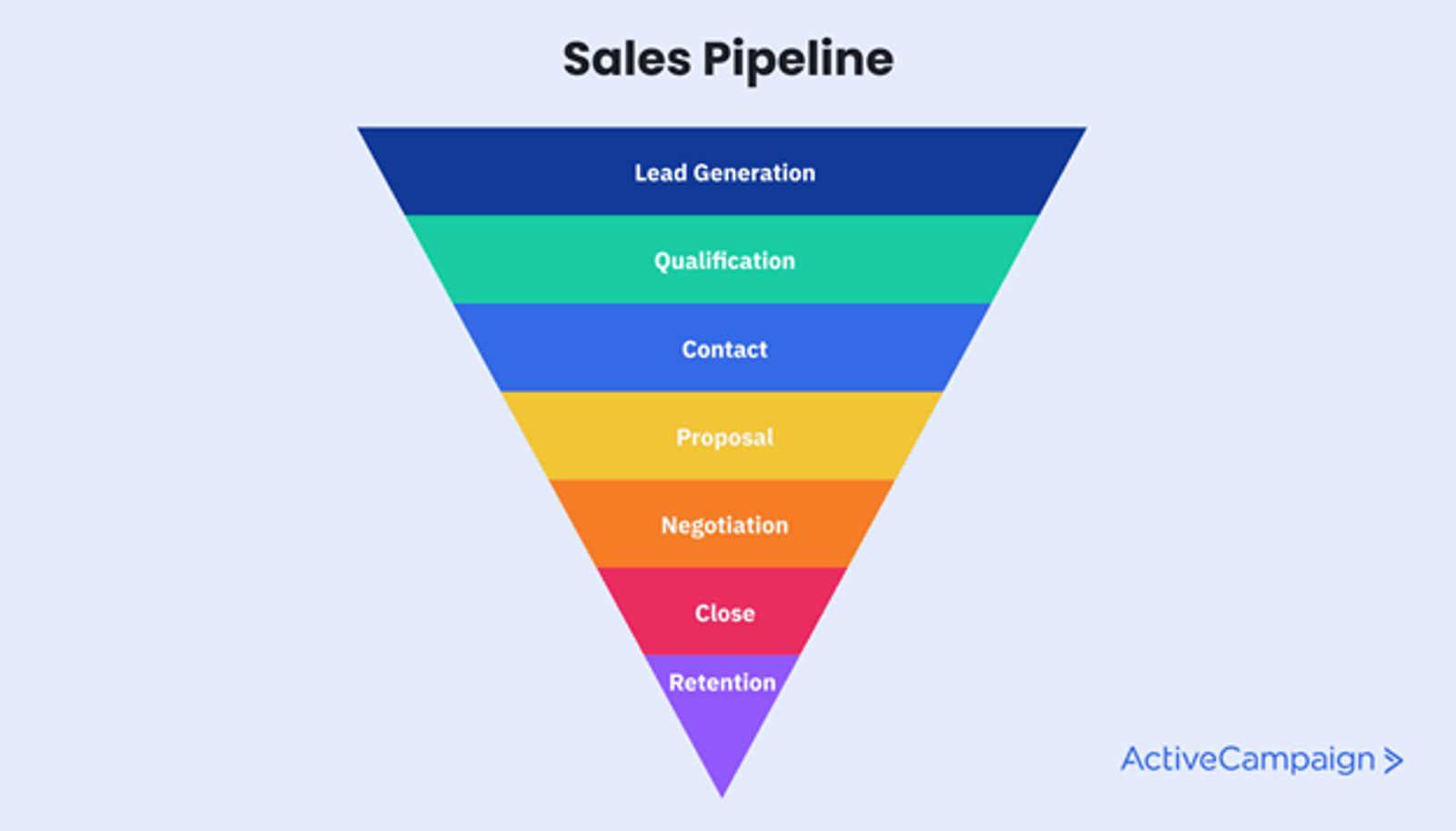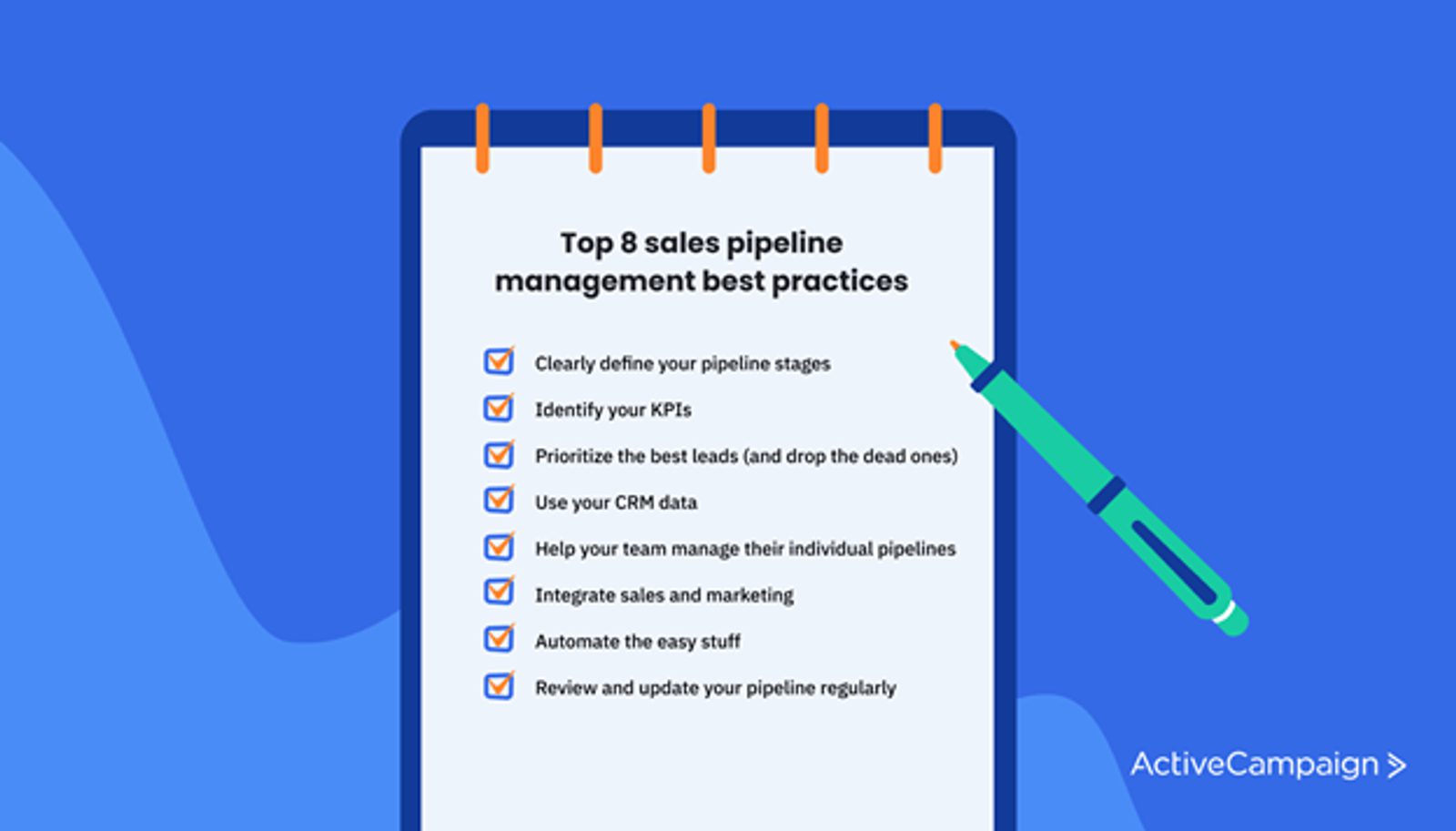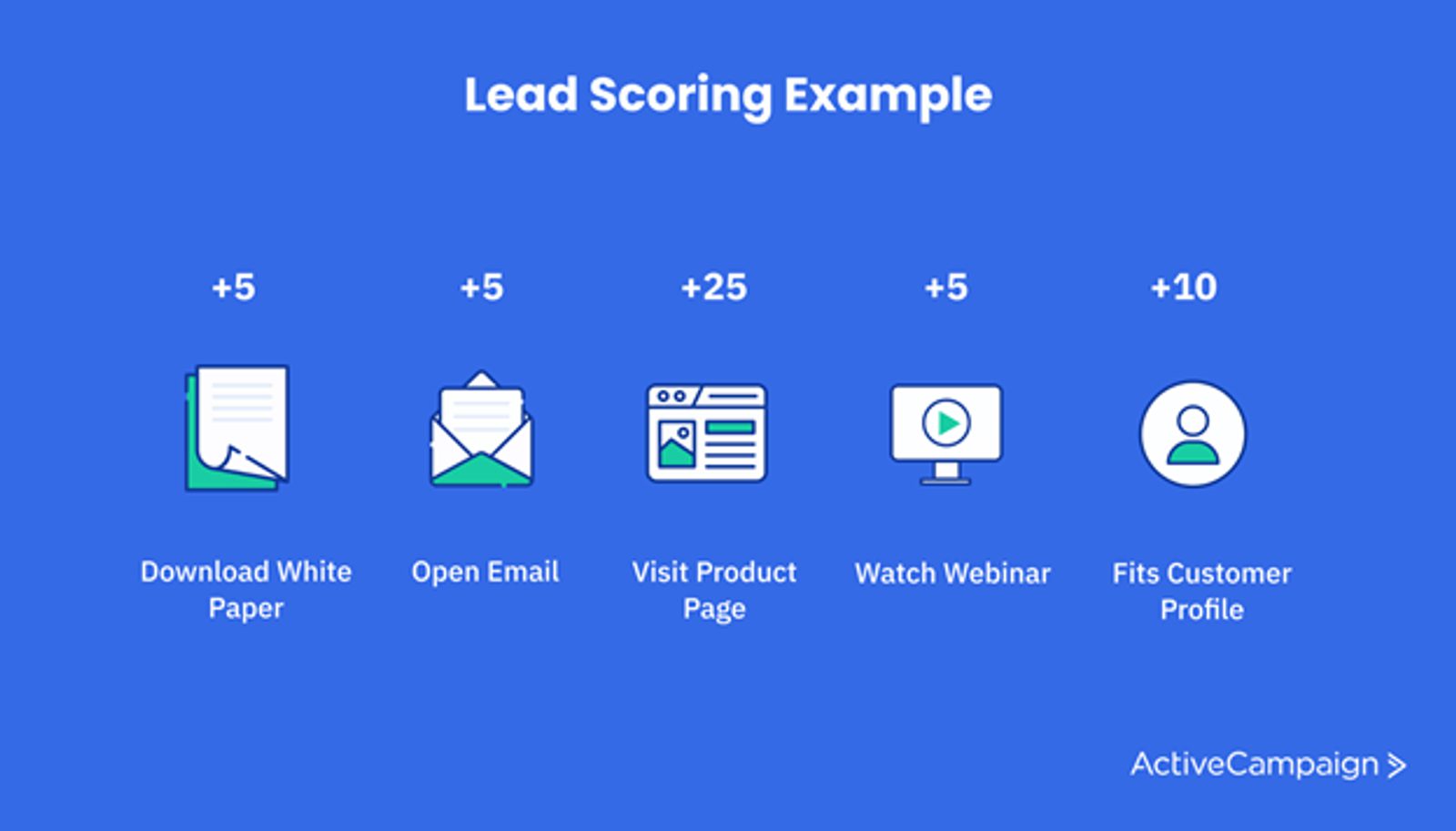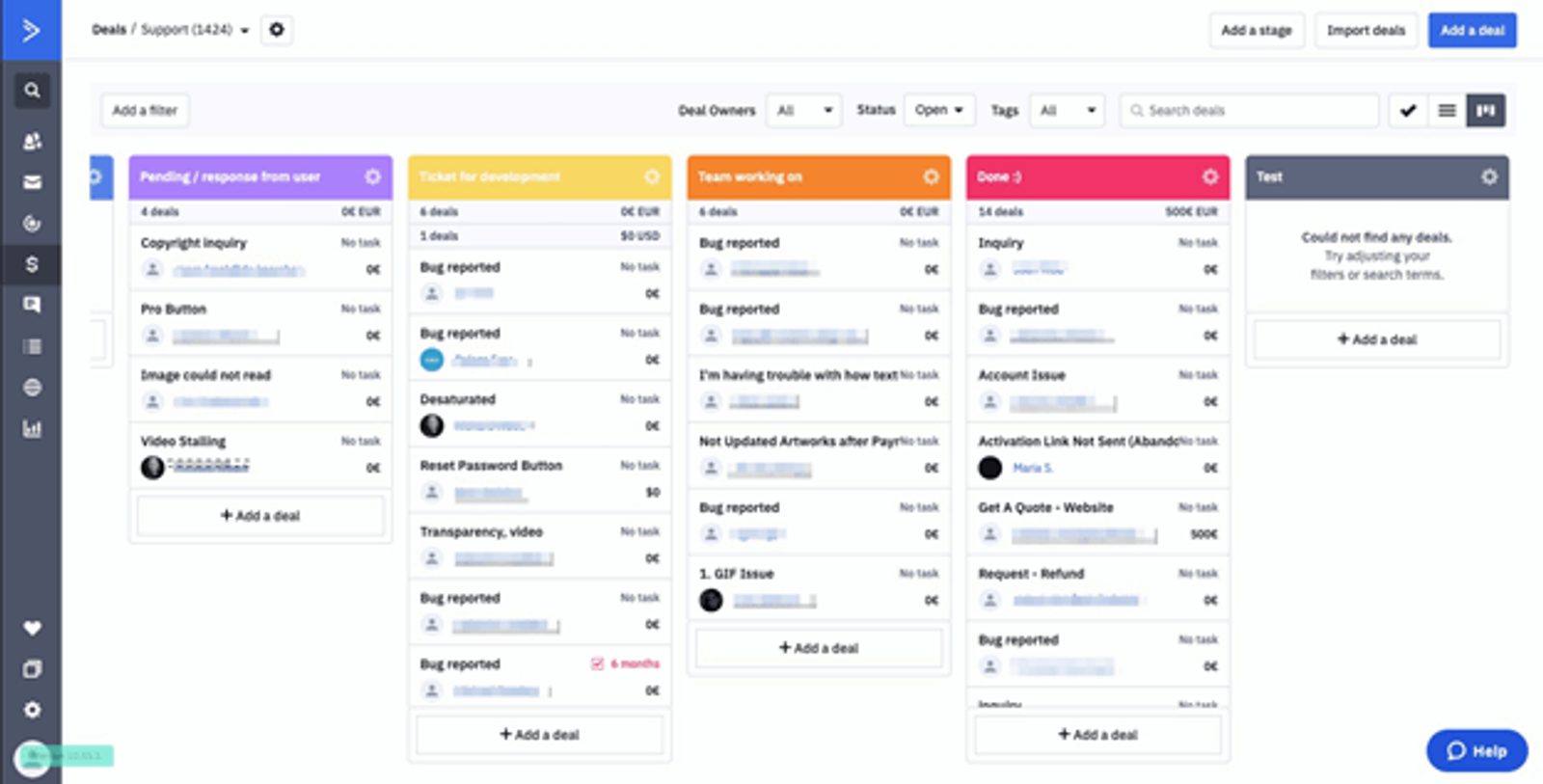Your sales pipeline lets you track your prospects on their journey from lead to loyal customer. And how you manage your pipeline can make or break the sales process.
Poor sales pipeline management leads to deals falling through the cracks, time wasted on low priority leads, and other similar issues. While following pipeline management best practices can streamline the sales cycle and result in more deals and revenue.
But how do you manage your pipeline effectively, especially as your business grows?
This article introduces the core principles of effective sales pipeline management and how to implement them.
What is a sales pipeline?
A sales pipeline is a method of tracking potential buyers as they progress through the purchasing process.
It’s usually represented as a set of stages that a person goes through on their way to becoming a customer. At each stage, the sales team takes certain actions.
The same organization can have multiple pipelines because customers who buy different products often go through a different set of stages before signing the contract.
Sales pipeline example
Every business will have its own unique sales pipeline (or multiple pipelines), but they often follow a similar pattern.
The typical pipeline starts with prospecting or lead generation and then moves the lead through a series of interactions with the sales team that eventually results in conversion. The final stage of the pipeline focuses on customer retention and loyalty.
Here’s how that could look:

- Stage 1, Lead generation: Marketing strategies are used to attract leads and build interest in your product.
- Stage 2, Qualification: The list of leads is narrowed based on pre-determined criteria.
- Stage 3, Contact: A sales representative reaches out.
- Stage 4, Proposal: You send a sales pitch with an estimate or proposal to the prospect.
- Stage 5, Negotiation: You negotiate the terms of the deal.
- Stage 6, Close: The customer makes a purchase.
- Stage 7, Retention: You implement various strategies to keep customers loyal after their purchase.
Of course, not every prospect will make it all the way through the pipeline, but pipeline management will help you maximize closed deals and minimize meaningless sales calls.
What is pipeline management?
Effective pipeline management means overseeing and optimizing the sales pipeline. It can be any combination of processes and tools that keep the pipeline flowing smoothly.
Why is sales pipeline management important?
Continually optimizing your pipeline does take some time and effort. Why should you bother to do it?
Here’s what you can achieve through the sales pipeline management process.
Effectively prioritize sales activities.
A well-managed pipeline helps you see which deals should be the highest priority. Important clients won’t fall through the cracks, and you’ll understand which leads have the most potential.
Streamline the sales cycle.
Managing your pipeline saves time by eliminating unnecessary work and automating tedious manual tasks. You can shorten the average sales cycle, giving you time to close more deals.
Analyze and optimize your processes.
Pipeline management gives you insight into what’s working and what’s not. Instead of continuing to work inefficiently, you’ll drop the activities that don’t make sense and do more of the activities that close deals.
Types of sales pipeline management tools
Sales pipeline management doesn’t have to be challenging. With the right tool, it’s easy to do. There are two main ways that companies manage their pipelines: spreadsheets and customer relationship management (CRM) software.
Spreadsheet
Plenty of small businesses start out using a spreadsheet to keep track of deals instead of a formal sales process.
There’s nothing wrong with that, as long as you only do a few deals at a time. It’s quick and easy to look at three names on a spreadsheet and decide which one to call.
But what happens when you experience rapid sales growth? What about when you’re getting new leads every day?
It becomes increasingly difficult to keep track of everything and some names might not get entered into the spreadsheet. You have a long list of deals that need attention, and you’re not sure what to do first. If your sales team has also grown, you start to get confused about which rep is doing what.
Even worse, you can’t see the big picture anymore. With hundreds or thousands of spreadsheet entries, you don’t know what’s working or which leads are most likely to turn into customers.
If you’re experienced any of those issues, it’s time to consider a CRM.
CRM
A customer relationship management system helps you efficiently manage your customer information and interactions. It has some big advantages over the spreadsheet method.
Automation
A CRM can take a lot of tedious, manual work off of your hands. For example, you can send automatic emails to segments of your customers, automatically generate reports, or receive automatic notifications when it’s time to contact a lead.
Lead scoring and forecasting
Lead scoring is a core feature in most CRMs, which lets you prioritize leads based on the criteria you define. For example, a lead might have a higher score if they live in the right area or if they’ve engaged with certain content.
CRMs can also make predictions about your sales operations, like assessing customer win probability and how much revenue you’ll likely generate.
Task management
With a CRM, sales reps can get a straightforward list of tasks to complete. They’ll never miss an important opportunity to engage, and they don’t waste time figuring out which leads need attention.
8 sales pipeline best practices
You’ve chosen your pipeline management tool and are ready to get started. Now what?
These are our eight top tips for managing your sales pipeline.

1. Clearly define your pipeline stages
The first step to managing your pipeline is knowing exactly what the pipeline looks like. Each stage should be clearly defined, not just with a name but with clear action steps for the sales team to take.
If you haven’t created your pipeline yet, now is the time.
Start by mapping your customer journey to understand how a lead usually makes its way through the sales process. What could sales or marketing do at each touchpoint to nurture the prospect?
Also, talk to your sales team about what they’re already doing. You can take the existing effective processes and build them into your new pipeline.
2. Identify your key performance indicators (KPIs)
To optimize your pipeline, you need to measure its success. If you’re tracking KPIs for each stage, you can identify the pipeline’s weak points and fix them. You’ll know if you’re progressing toward your goals or just standing still.
Think about what success looks like at each stage of the pipeline. For example, most businesses will track their win rate, sales velocity, or if they meet their sales quota. However, don’t forget to track key metrics for the early stages of the pipeline, like how many leads become qualified leads.
One thing to look at is the drop-off rate at each stage. Are people losing interest early on, or are they backing out when negotiations start?
You can also track metrics that reflect the success of the whole pipeline, like the length of the sales cycle or the average deal value.
If you’re using a CRM, you can use it to generate reports on your KPIs automatically.
3. Prioritize the best leads (and drop the dead ones)
We mentioned the lead scoring capabilities of CRMs earlier.
Whether you’re using an automated system or your own calculations, you should know which leads to prioritize. As your business grows, you simply can’t give all prospects equal attention.
Don’t be afraid to drop the leads that are going nowhere or don’t have the budget to afford your products. You need that extra time to foster relationships with high-value potential customers.

4. Use your CRM data
Your CRM houses a wealth of knowledge about your customers, prospects, pipeline, and your team’s sales performance.
Use that information to optimize your processes. Did you find a particular type of lead that doesn’t usually pan out? Update your lead scoring formula and create a new standardized sales process.
Review the data you have available in your CRM to determine how you can use it to improve the pipeline.
Maybe you’ve been collecting website behavior data that could be useful for scoring leads. Maybe your CRM can generate a report that would help your reps work more effectively.
5. Help your team manage their individual pipelines
You can build the perfect pipeline and use a state-of-the-art CRM solution, but it means nothing if the people on your sales team don’t know how to use it.
So you must provide training on your pipeline, sales strategies, CRM, and other business technology.
Make sure everyone understands how prospects tend to move from one stage to the next — how long do they spend at each stage? What are their concerns at that point in the process?
Your CRM solution can help the whole team perform well. Reps know which sales deals to focus on, and they (and sales managers) can see a sales dashboard of how well they’re doing.

Coaching them on how to use the CRM and follow pipeline best practices ensures they’ll make the most of their time and resources. It can also help you forecast future revenue.
6. Integrate sales and marketing
Sales and marketing want the same thing — to acquire more loyal customers.
Unfortunately, in many businesses, the two departments are siloed.
The marketing department sends email nurture campaigns and develops lead generation strategies that the sales team doesn’t even know about. Marketing isn’t aware of how prospects from different channels tend to convert in the pipeline.
It’s a confusing experience for the customer and an ineffective workflow for the teams.
When marketing and sales have a complete overview of pipeline activities, they can work together toward common goals. Both teams see how their efforts affect sales and deal sizes, and prospective customers receive a unified message.
7. Automate the easy stuff
Human relationships are the heart of sales.
But you don’t have time to build relationships with your potential customers if you’re bogged down in busywork. Automating pipeline processes frees your team up to do the critical tasks that lead to sales. The more time your team can spend on a key sales activity like sales calls or proposals, the better.
Make sure you’re familiar with your CRM solution’s automation capabilities. Take advantage of sales automation wherever you can.
8. Review and update your pipeline regularly
Let’s say you’ve optimized your pipeline, and everything is going great! You’re meeting your KPIs and sales targets and closing more deals than ever.
This is not the time to get complacent.
Maybe a new competitive landscape will require changes to the pipeline. Or your processes will need to be adjusted for your increasing lead volume. You could even release a new product that requires different pipeline stages.
Make time to review your pipeline processes regularly — for example with quarterly sales pipeline review meetings. Check the data and talk to your team about what’s working (or not) for them.
Sales pipeline management case studies
We have some great examples of companies that are using ActiveCampaign sales CRM to manage and optimize their pipelines, check them out below.
McCrindle
McCrindle is a social research, demographics, and data analytics agency that counts more than 100 of Australia’s largest companies among its clients.
With their diverse client list and range of offerings, one pipeline wasn’t enough. They needed to be able to deliver a personalized experience to each prospect without a lot of manual work.
McCrindle created multiple custom pipelines in ActiveCampaign. A marketing executive says:
“All of our clients have a bespoke proposal and specific requirements. ActiveCampaign’s pipeline stages allow us to know who is where in each stage and how we are progressing with them.”
Party Headphones
Party Headphones is a provider of silent disco headphones and equipment. They use a single pipeline for the sales cycle but have created pipelines for other parts of the customer journey, like fulfillment.
ActiveCampaign lets the team easily track orders across the entire fulfillment process. Alec of Party Headphones says:
“If a client doesn’t return their equipment right away, we can move them to a different pipeline, assigning tasks to team members to follow up with a call, and everyone is always on the same page.”
Artivive
Artivive is a platform for augmented reality art. The Artivive team uses ActiveCampaign pipelines to manage its sales cycle and its support ticketing process. Artvive founder Sergiu says:
“It’s very easy for our colleagues to follow and see how long a client has been with us, or what the email conversation was until now. How can we help? It’s everything you need in one system.”

Conclusion
Pipeline management is key to streamlining the sales cycle and winning more deals.
The first step is choosing the right tool.
ActiveCampaign integrates sales and marketing automation to provide your potential customers with a positive and cohesive experience through every stage in the pipeline.
If you want to level up your sales and marketing processes, try ActiveCampaign for free for 14 days.








